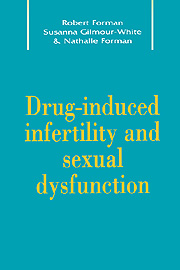9 - Fertility and the environment
Published online by Cambridge University Press: 30 March 2010
Summary
Introduction
We live, work, eat and breathe in an environment filled with agents that have the potential for reproductive toxicity. There are over 60 000 chemicals in use in manufacturing processes and over 500 are added each year. Men and women can be exposed to these agents if they work in manufacturing industries producing or utilising the products; however, we all consume and accumulate chemicals because of our position as the terminal link in the food chain. We drink contaminated water. We are in contact with toxic chemicals when we decorate our houses and indulge in our hobbies. We are surrounded by sources of ionising and non-ionising radiation. In short it is impossible to avoid exposure to potential reproductive toxicants.
Certain environmental agents (comparatively few) have been proved by rigorous experimentation to have a major deleterous effect on reproductive performance. Many more have been linked to reproductive dysfunction but hard proof is lacking. It is highly likely that several environmental toxicants have as yet undiscovered adverse effects. Furthermore, we are exposed daily to low levels of toxicants, lead and radiation for example, which are known to have serious adverse effects on reproductive functions above certain threshold levels. Maximum permitted exposure levels have been calculated, but it is impossible to predict a level that is not harmful.
Reproductive toxicology is a very new branch of occupational medicine. The first significant report describing the effect of the pesticide dibromochloropropane (DBCP) was only published in 1977. There is now much more consumer interest in environmental issues in general and the importance of toxicants as a cause of infertility is starting to create deep concern in both lay and scientific communities.
- Type
- Chapter
- Information
- Drug-Induced Infertility and Sexual Dysfunction , pp. 124 - 146Publisher: Cambridge University PressPrint publication year: 1996



